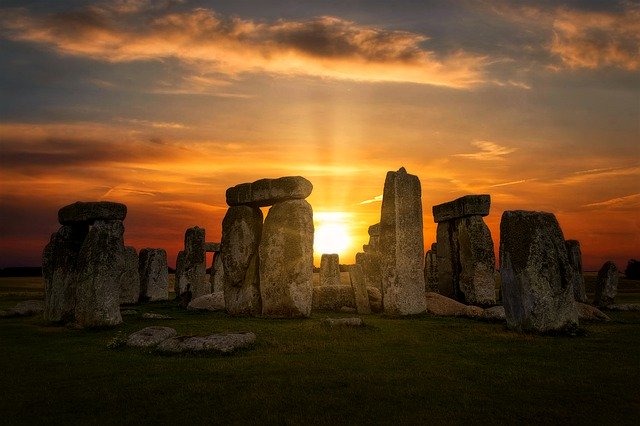
Summer Solstice: A Time of Renewal and Looking Forward..
The summer solstice, which takes place on June 21st in the Northern Hemisphere, marks the longest day of the year, and the shortest night. Each day after the solstice, the days begin to get shorter and the nights longer, until December 21st – the Winter Solstice – on which we see the year’s longest night and shortest day.
We all know that the Earth orbits the Sun. What you may not have known is that the Earth’s axis always points in the same direction as it orbits, meaning that the Northern Hemisphere – anything above the equator – is angled toward the sun for one half of the year, and away from the sun for the other half.[1]
Ancient Celebrations
Since ancient times, the summer solstice has been celebrated around the world, across a variety of different cultures. Rites and rituals were performed as ways of celebrating the Sun and it’s gifts to Earth and its people – gifts of light, renewal, and fertility. From the Greeks to the Romans, to the Pagan religions, the summer solstice was a very important day in the calendar.
For the Greeks, the summer solstice marked the new year, the countdown to the Olympics, and aligned with Krona, a festival in celebration of the god of agriculture, Cronus.
For the Ancient Egyptians, summer solstice occurred around the time that banks of the Nile would flood, leading to an abundance of crops.
Vestalia was an ancient Roman festival that took place around the summer solstice, during which offerings of food were made to goddess Vesta.
In Pagan cultures, feasts and dancing took place around a bonfire, which was lit to eliminate evil spirits and cultivate magic.
The significance of the summer solstice can be observed at Stonehenge. The sun sets on the heel stone of the mysterious monument on the night of summer solstice, and shines through all the others.
Modern Day Summer Solstice
In modern times, there is less ritualistic celebration of the summer solstice, due to a move away from Pagan religions and towards Christianity in the Western world in particular, but this doesn’t mean that is not celebrated. For many people, the solstice is met with parties and events to celebrate the coming of summertime. But parties and drinks with your friends isn’t the only way to celebrate. The Summer Solstice can be a time to reconnect with yourself and your family, and set positive intentions for the rest of the year.
Although not many people take part in the rituals of sun worship to mark the time of year anymore, there are still ways to celebrate and acknowledge the change in season.
For one, try spending more time outdoors. Winter comes all too soon and it’s not a great feeling when you realise that you didn’t make the best of the summer sunshine. Organise family or friends to take a camping trip and sleep under the stars. Bring food and have a picnic, or just go for a walk in nature. Besides the sun’s loving warmth on your skin, spending time outdoors – especially in the summertime – has a whole host of benefits for your well-being.
Reconnect with your ancestors and plan a bonfire! Around the world, but particularly in Northern and Central Europe where Slavic, Germanic and Celtic cultures originated, bonfires were an important part of the summer solstice celebration. People danced around the fire, and in some cultures young men would jump over the fire in a gallant display of bravery and fearlessness, which also served to purify the soul and burn away evil intentions. While we’re not encouraging anyone to jump over a fire, some night time dancing in a tribute to our ancestors might be one way you can celebrate!
A long-standing celebration of renewal and looking to the future, the longest day and shortest night is a great time to set goals and intentions for the months to come. Take some time to think about how the year has been for you so far – what did you achieve? What were happy with, or disappointed by? Accept the year’s journey so far and recalibrate your intentions to make the best of the rest of the year.
Before Christianity, many cultures were Pagan, and worshipped the Sun. And it’s easy to see why. Sunlight is what feeds life on our planet, so it’s clear to see why people in ancient times had so much praise and gratitude for the life-giving fire in the sky. The height of summer means that fresh fruits and vegetables are in abundance, so make sure you organise a delicious feast and eat with your closest friends and family if lockdown permits. Mark the occasion by decorating your home, or better yet, your garden, with flowers and lanterns, and create a beautiful scene in which you can enjoy some delicious food.
How are you going to celebrate this year’s summer solstice? Will you offer food to the Gods like the Romans? Or light a bonfire and dance like the Pagans? Maybe you’ll have a picnic and go for a walk. Whatever you choose to do, let it be a time of renewal and looking forward.
Sources:
[1] NBC News. 2018. What Is The Summer Solstice? Here’s The Science Behind The First Day Of Summer. [online] Available at: <https://www.nbcnews.com/mach/science/what-summer-solstice-ncna884991#:~:text=When%20the%20Northern%20Hemisphere%20is,time%20of%20the%20summer%20solstice.> [Accessed 5 June 2020].